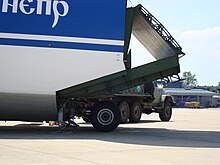Loading ramp

The term loading ramp , and ramp , ramps , loading ramps , called an inclined surface for traversing a wheeled vehicle or transport goods on wheels or rollers .
In contrast to structurally fixed or naturally created larger ramps , this usually means a support surface or roadway temporarily placed between two levels of unequal height . Is very often the execution of steel - or aluminum - profiled sheet with or without pronounced lateral boundaries.
There are different types of ramps, depending on the design and the purpose of use, with overlapping purposes or designations.
Differentiation according to the narrow application purpose
Wheelchair ramp
Main article: wheelchair ramp
A wheelchair ramp is designed in terms of track width and load capacity for use with wheelchairs including the person sitting in it, or only for loading a heavy electric wheelchair . They can be used as transportable products that can be used at various locations as required, or as add-on components to vehicles.
Quad ramp, lawn mower tractor ramp, motorcycle ramp
In terms of its track width and load-bearing capacity, the ramp is primarily designed for quad and lawnmower tractor vehicles or motorcycles .
Door sill ramp
The ramp consists of a one-piece surface and is primarily intended to be used to overcome a single entrance step for people with wheelchairs or with a stroller.
Curb wedges
Curb wedges are short, ramp-like surfaces that can be used to create a flat transition along a curb .
Differentiation according to mobility
Installation ramp
As built ramps and dock leveler called ramps are often referred to, which are connected at least on one side with a building or a transport vehicle. It can mean both an immobile connection (especially on buildings) or a foldable connection (especially on vehicles).
Folding ramp
Folding ramps are connected on one side to the entrance or the loading area of a transport vehicle, less often to a building.
Mobile ramps
Mobile ramps are placed between the uneven levels and removed again without fastenings; they can usually also be easily transported. They are often only used when there is local demand or at locations that change depending on the application.
Differentiation according to the type of construction
Rigid ramps or loading ramps
The ramp has no moving parts. Products of this type can be used as fixed or mobile ramps.
Folding ramps
The ramp consists of two or more parts, which are connected to one another by movable joints and which can be folded together lengthways for the purpose of transport. They are mostly used as mobile ramps.
Telescopic ramp, telescopic loading ramps
The ramp consists of two or more parts that are mutually interconnected and can be pushed together for the purpose of transport. They are mostly used in mobile applications as narrow ramps used in pairs.
Trunk ramp
The ramp consists of two or more parts, which are connected to one another by movable joints and which can be folded across to approximately suitcase size for the purpose of transport. They are mostly used as mobile ramps.
Broad ramp
The ramp consists of a relatively wide one-piece surface. The designation is mainly used to distinguish it from narrow, paired loading or loading rails.
Heavy duty ramp
The ramp has a particularly high load-bearing capacity for loading heavy loads or vehicles, for example construction machines onto low-loaders .
literature
- Thomas Kaufmann: ABC of forklift drivers . 1st edition, Beuth Verlag GmbH, Berlin 2011, ISBN 978-3-410-20722-1 .
- Thomas Kaufmann: Industrial trucks . Optimal planning and efficient use, 1st edition, Beuth Verlag GmbH, Berlin 2013, ISBN 978-3-410-22065-7 .
